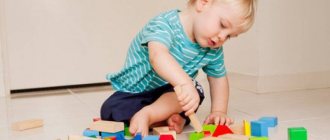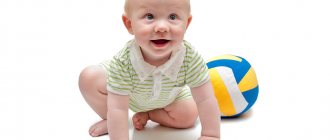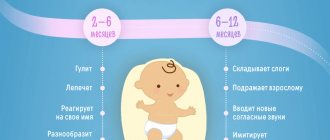There is only a month left until the baby's first birthday. Look at newborn photos and you'll see how much has changed in that time.
Now the baby needs an “eye and an eye”; he has mastered the first steps and is trying to explore everything that surrounds him. It's time to take stock. And parents want to know whether the child is developing harmoniously at 11 months.
Don't be upset if your baby doesn't exactly meet the guidelines given in the article. All children grow at different rates: some skills may be mastered several weeks earlier, while others will take a little longer. Do not doubt that over time the child will cope with all the tasks.
Increase in weight and length of a child's body at 11 months
Do not forget about the individual developmental characteristics of the child. If, for example, mom and dad are short, then the baby has the right to be below average height.
| Boys | Girls | |
| Weight, kg | 8,9-11,8 | 8,5-11,5 |
| Body length, cm | 71-78,9 | 70,3-77,1 |
| Head circumference, cm | 44,6-49,3 | 43,9-48,7 |
| Chest circumference, cm | 44,6-52,2 | 45,8-50,8 |
The approximate weight gain per month is 400 grams, body length increases by 1.5 cm.
What can a baby do at 11 months?
The baby is 11 months old! It becomes much easier for the mother, since the period of complete dependence of the baby is over.
The baby stands well without support, begins to take independent steps, and some are already running.
The little one plays entertainingly for a long time: builds a tower out of cubes, assembles and disassembles a pyramid. Signs of role-playing play appear: feeding a doll, rolling a toy in a car. All this is thanks to the active imitative activity of adults.
Speech appears, its own language, understandable only to him and his parents. 11 months is the period of active onomatopoeia. The baby will be happy to repeat how a dog barks, a cat meows or an airplane hums.
All these achievements of the baby depend on the fruitful work of mom and dad.
The child is happy to try to eat with a spoon, do not interfere with this in any way, but rather encourage it. He can already drink from a mug on his own.
View information for other months:
1 2 3 4 5 6 7 8 9 10 11 12
Should I give my child vitamin D in the summer?
11 month old baby's daily routine
So that your baby is cheerful and not capricious, so that he doesn’t get overtired and you have time to do everything, try to follow a daily routine. Sleeping, feeding, playing, walking should be around the same time.
Approximate daily routine
I will give an approximate daily routine for an 11-month-old child, if he wakes up at 8 o’clock in the morning.
8:00 — the baby wakes up. I think morning is the most pleasant time of the day. The baby is so sweet, gentle, happy with his mother, smiling, stroking her face, as if he missed her overnight.
9:00 - breakfast. Next, the child plays or you can conduct developmental classes or massage and gymnastics.
11:00-13:00 - first dream. It can be both on the street and at home. Before bedtime, you can give your child a second breakfast. It could be fruits or vegetables, a fermented milk drink.
13:00 - dinner. Then the baby plays again or after lunch you can go for a walk.
17:00 - afternoon snack and second nap.
19:00 - the baby wakes up and plays.
20:00 - dinner.
21:00 - bathing, getting ready for bed. You can bathe your baby before dinner, for example at 19:00.
22:00 - night sleep.
What should be the daily routine?
Doctors' recommendations for a daily routine include the following:
- The baby's sleep should be long. As a rule, the average baby, who has no health problems, sleeps for about an hour or a little more during the day and 8-11 hours at night. Pediatricians recommend that parents pay great attention to walks with their baby. This will allow the body to be better saturated with oxygen. It is advisable to walk with your child in the morning. Walks taken in the afternoon for 5 to 6 hours will be no less effective.
- In order for the baby to sleep peacefully and not be capricious before bedtime, pediatricians recommend completely eliminating outdoor games with the baby at this time. A very effective way to create the right mood for a child before bed is reading a book or a light massage.
- Children at this age are already taught oral hygiene. Pediatricians advise starting a similar procedure from the moment the first tooth erupts. This will help prevent future tooth decay. Parents should carry out such manipulations, carefully cleaning each baby’s tooth. A little later, the child himself will learn to do this efficiently and effectively.
- After sleep, the baby should be placed on the potty. If the child is still afraid to sit on it, then it is best to postpone potty training for a while. Some parents toilet train children as young as 11 months. This can be done, but it is best to use a special stand for babies with a soft seat. At the same time, you need to make sure that it is not cold. After using the toilet, the baby should be washed or used wet wipes.
Read: Features of the development of a newborn child by week, stages of development in the table
As for water procedures, children at this age are bathed at least 4 times a week. You should not give up a daily bath if your child has a positive attitude towards it.
On the video about the developmental features of a child at 11 months:
21 Sep 2021 Yuki 488
Share this post
We recommend reading along with this article
- What a 4 month old baby can do - description...
- When a child begins to speak in sentences - in detail...
- How to choose the right toys for babies
- Feeding, sleeping, staying awake in the mode of a 2 month old baby
- Games with a baby: what to do with a 6 month old baby...
- How to develop a child at 4 years old physically and intellectually
- How to make a children's room with a unique and inimitable design
- Children's tantrums - what they are and how to deal with them
- What does the growth chart for a child up to one year tell you?
Baby's nutrition at 11 months
The child's diet is becoming wider and wider.
You can experiment and use your imagination. The porridge can be multi-grain with the addition of pieces of various fruits. Multi-component vegetable complementary food with the addition of greens. Meat and fish complementary foods in the form of meatballs, steamed cutlets, soufflés or simply pieces of meat (fish). This is necessary for the child to practice chewing. In the process of chewing, the maxillofacial apparatus develops, and subsequently speech. Approximate menu for a child at 11 months
Tomorrow : multi-grain porridge, 200 g with added butter.
Lunch : salad of fresh vegetables, cooked on a coarse grater, 50 g. Children's vermicelli, 100 g with steamed cutlet, 50 g.
Midday : kefir, 200 ml
Dinner : cottage cheese soufflé with pear, 200 gr.
After meals, you can offer your child something to drink (water, compote without sugar). Don't give your baby sweet drinks between meals to avoid curbing your appetite. And only from a mug, and not from a bottle with a nipple.
Breast milk can, of course, be present in a child’s diet. If the child is bottle-fed, then formula 1-2 times a day.
Development activities
The baby is becoming more and more active, mobile and very curious. But he still needs the closeness of his family, especially his mother. Good dialogue and contact with the child is established during the reading process. Let him play with cardboard books, look at the pictures, and tell him what the baby sees in them. Read, changing intonation, or sing if there are songs in the book.
For the development of speech, it is useful to read books to babies
But don’t make the process tiresome: your baby can’t focus on one activity for a long time yet. Read a short verse, look at the photo on the page and let your little one get distracted, then continue reading from the next page.
Children especially love books with protruding illustrations or those that make sounds. Help your child develop pronunciation. If the baby mumbled a word, try to find the named object with him.
Examples of speech games:
- skits with the words: “na” - give the child an object, “hello” - shake his hand, “give” - extend your palm to him;
- Show your baby familiar toys, saying their names. Objects that the child sees often are also suitable for play: a spoon, a stroller, a book, a chair, etc. It is better to choose noun objects, the baby remembers them better;
- expand your vocabulary. Don’t get tired of naming everything that interests the baby: the names of relatives and friends, children on the playground. Repeat the sounds of animals, showing your baby images in the picture, and very soon your baby will tell you how a cat says “meow” and a cow moos.
Child at 11 months. I am very interested in objects that adults use. Use his desire when preparing food. Name everything you do in the kitchen: the name of the products, the utensils used, your actions, for example, porridge, cooking, sweet, salty, cutting, cleaning, etc.
Let your baby take part in the process: let him wash the spoon in a bowl of water, throw a piece of carrot on the plate. While playing, the baby will learn and love to work. At this age, a child does not just play with a bear or a doll. The game turns into a whole performance: feed, put to bed.
To do this, the baby must have everything he needs: toy dishes, a crib, a dining table or even a doll house. Change toys periodically so that they do not get bored, and do not offer everything at once - the baby will quickly lose interest in them.
The following games are suitable for developing fine motor skills:
- finger painting on small grains: semolina or flour. To do this, pour it on a tray, take the child’s finger and help him draw something simple: the sun, a fish, a funny face. In the future, allow the child to “create” on his own;
- drawing with a thin pencil or felt-tip pen;
- modeling from plasticine. The child must learn to roll out a sausage from plasticine, cut it into pieces and make balls;
- pouring cereal or sand from one mold to another. This procedure can be repeated when bathing: babies love to pour water and fill various containers with it.
Communication with other children promotes full development. It is best to do this in special areas where peers or older children walk. Do not interfere with games, let the child learn to communicate on his own.
Learn new actions every day. Encourage any success of your baby, praise and support him emotionally.
Baby massage at 11 months
During the period from 11 to 12 months, standing without support and walking are actively developing. New elements of motor skills appear (squatting), so it is recommended to pay special attention to the squatting exercise. All actions that you perform need verbal accompaniment. And finally the time has come to give commands to the child, which he is ready to carry out. It is important that the child enjoys massage and gymnastics; do not insist if he does not want to.
The set of exercises and massage is the same as in the 9th month , but there are small additions.
1. The child can perform alternating flexion and extension of the legs, imitating walking, independently, at the verbal request of the parent.
2. After you have completed the circular movements with your hands together, ask him to do them himself.
3. During squats, support your baby with only one hand.
Nutrition for an 11 month old baby
By the age of one year, the baby already has as many as 8 teeth, and he can try denser foods, while actively developing chewing movements.
The nutrition of a baby at 11 months resembles the diet for adults: cereals and vegetables, yoghurts and cheeses, lean meat, fruits, buns, cookies. Most of the menu: crushed cereals, purees, any steamed or boiled food.
But there are foods that you should hold off on: citrus fruits because they can cause allergies, high-fat milk, any fish because they are difficult to digest. You should not give your child spicy, fried or smoked food. Encourage your baby to regularly try new foods with unfamiliar flavors.
Even if the child does not like the food the first few times, over time he will get used to it. Solid food becomes a priority in the overall diet, but the baby still needs 500 ml of milk per day (preferably breast milk): in the morning, at lunch and before bed. If the baby drinks more than this norm per day, he will be full and refuse to eat during the day.
This can lead to an outbreak of night hunger: the baby will wake you up and demand milk.
As a result, by the morning he will not be hungry, and everything will repeat. How to fix the mode? Try to eliminate night feeding or replace it with water.
It will be difficult, but if you can handle it, the baby will be hungry in the morning, and the feeding pattern of 3 solid meals and daily milk will be restored. If your baby drinks milk from a bottle, it’s time to move on to a sippy cup with a straw spout. This design will help the baby master the skill of swallowing.
The bottle must be abandoned by 18 months, otherwise the child will get used to taking it with him to bed and sipping it all night, which is dangerous for the development of caries. If your baby's teeth are not growing well, do not indulge in solid foods.











